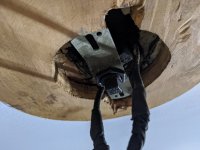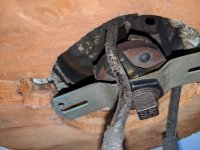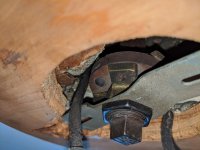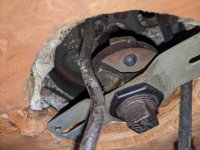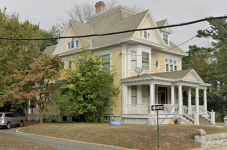It's too hot to work on my porch right now, so I've turned my attention indoors. 
Last weekend I floated out some bad crack repairs in the ceiling and repainted everything. Of course, once the ceiling had a fresh coat of flat white paint on it, the ceiling fan which came w/ the house no longer looked classy very good (it didn't before either, but it got worse..). I disassembled the old fan today to see what was going on up there and to put the new one in.
So, there are a number of issues which raise some concern. I figured I would run it by everyone here and see if someone had a good idea or solution.
I think the original lighting in the house was gas. There is black iron pipe which projects down from the ceiling about an inch, and the pancake box seemed to be installed around that. The ceiling wiring is still K+T, with the conductors each popping through a separate KO. The conductors look to be in good shape, although someone seems to have pigtailed on a small length of stranded wire to the ends of each of them. Since that is wrapped in friction tape, I don't know if it's soldered or just twisted on and taped (yes, I've seen that with this house before).
The way the previous owners had the fan installed, there is a bracket threaded to the end of the pipe. They added a circular disk of plywood to compensate for the pipe's projection into the room, and then attached the fan to the bracket, where the canopy would meet the plywood.
I'm pretty sure that the plywood is problematic in this case, although I guess technically the junction happened between the mounting plate + canopy.
I'm also not sure what type of weight rating a black iron pipe has when it comes to holding a fixture.
Also, neither of these things really works well for my new fan, which uses a short downrod and has a bracket for the same.
So I'm hoping some clever folks on here might know of some good options or solutions for this that don't involve cutting out a chunk of the ceiling (I can do that, but it's going to be nasty w/ the plaster/old paint/whatever up there). I'm not certain whether I'll be successful removing the iron pipe (it's been there a very long time, and from what I've read they tended to bend rather than use a fitting at the right angles), but I'm reasonably certain that it is not being fed at this time (the pipe in the basement which would be most likely is not connected to anything).
Here's some photos to illustrate the issue. I apologize for the quality - at the moment I was mostly focused on balancing
View attachment 1
View attachment 2
View attachment 3
View attachment 4
Last weekend I floated out some bad crack repairs in the ceiling and repainted everything. Of course, once the ceiling had a fresh coat of flat white paint on it, the ceiling fan which came w/ the house no longer looked classy very good (it didn't before either, but it got worse..). I disassembled the old fan today to see what was going on up there and to put the new one in.
So, there are a number of issues which raise some concern. I figured I would run it by everyone here and see if someone had a good idea or solution.
I think the original lighting in the house was gas. There is black iron pipe which projects down from the ceiling about an inch, and the pancake box seemed to be installed around that. The ceiling wiring is still K+T, with the conductors each popping through a separate KO. The conductors look to be in good shape, although someone seems to have pigtailed on a small length of stranded wire to the ends of each of them. Since that is wrapped in friction tape, I don't know if it's soldered or just twisted on and taped (yes, I've seen that with this house before).
The way the previous owners had the fan installed, there is a bracket threaded to the end of the pipe. They added a circular disk of plywood to compensate for the pipe's projection into the room, and then attached the fan to the bracket, where the canopy would meet the plywood.
I'm pretty sure that the plywood is problematic in this case, although I guess technically the junction happened between the mounting plate + canopy.
I'm also not sure what type of weight rating a black iron pipe has when it comes to holding a fixture.
Also, neither of these things really works well for my new fan, which uses a short downrod and has a bracket for the same.
So I'm hoping some clever folks on here might know of some good options or solutions for this that don't involve cutting out a chunk of the ceiling (I can do that, but it's going to be nasty w/ the plaster/old paint/whatever up there). I'm not certain whether I'll be successful removing the iron pipe (it's been there a very long time, and from what I've read they tended to bend rather than use a fitting at the right angles), but I'm reasonably certain that it is not being fed at this time (the pipe in the basement which would be most likely is not connected to anything).
Here's some photos to illustrate the issue. I apologize for the quality - at the moment I was mostly focused on balancing
View attachment 1
View attachment 2
View attachment 3
View attachment 4

